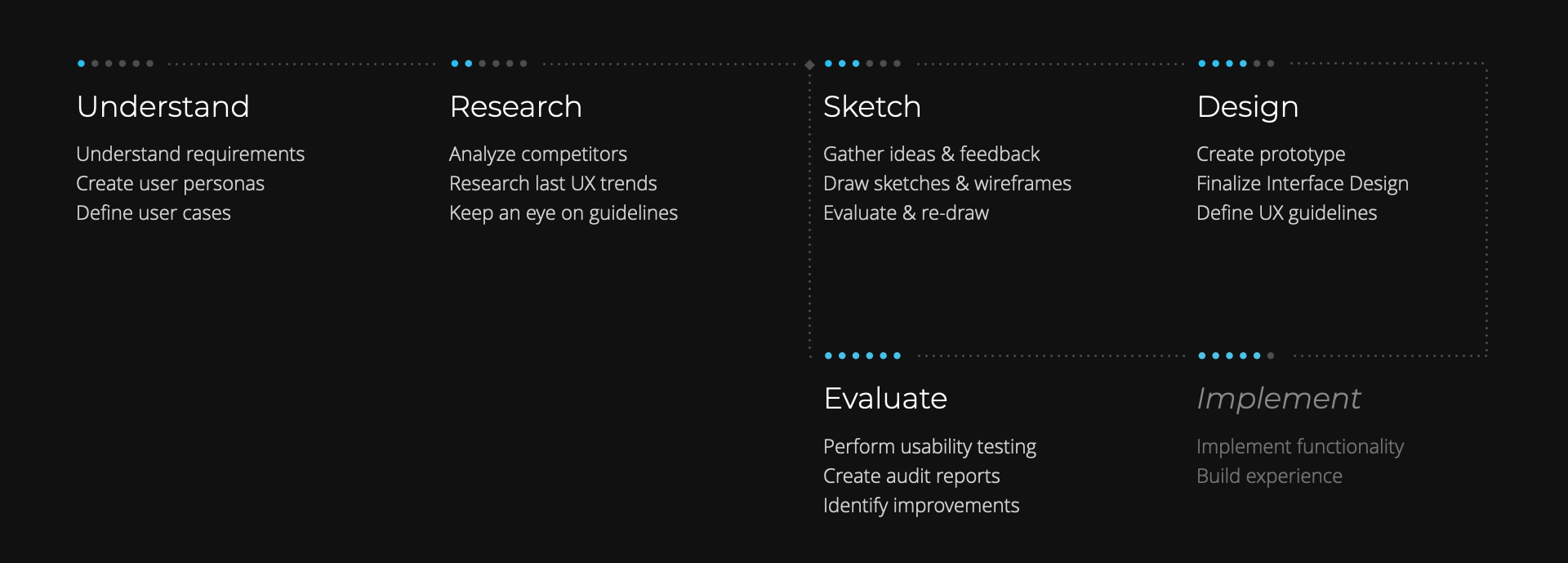
Step 1: Understanding.
It’s fundamental stage, which play the most important role in terms of future product & business objectives. Our task at this stage is to answer the main questions:
Who?
- Who is our Target Audience?
- What pain points do they have?
- What are our User Personas? How do we understand who our customer is?
How?
- How we can help our customers to solve their challenges with our solution?
- What are our most common user stories?
- What are the main requirements to be on focus in our potential customers?
Why?
- Why exactly this problem we decided to solve? Is it really our peak of opportunities & ambitions?
- Why we are the best solution for our users?
What?
- What concrete will we do to reach our goal?
- What is our UX strategy?
- What are our design development cycles?
We think it's obvious that with no thoughtful answers at these steps many crucial mistakes can be made without the possibility of fixing on the other stages. That's why we strongly recommend not to jump over this step and take a responsible approach to the process of determining the main tasks of our work.
Step 2 & 3: Research & UX Sketching.
After creating the job specifications, having built UX Strategy, User Personas & Stories, let’s try to find the right form for our product/solution.
First of all, we start with Researching Our Competitors . To build a great product, we need to look around. We have to define what works in the market, what does not work and who are the biggest sharks in the sea (that provide the same or similar product or service).
Secondly, we are trying to gather all the ideas & starting to sketch the first drafts. We explore last UX trends, competitor analysis report, everything that we have till now. Sometimes we skip a couple of work modules & start work on Low Fidelity Wireframes. After evaluating the core structure we work on High Fidelity Wireframes.
What kind of research methods do I use when starting a new project?
I'm a true evangelist of Design Thinking;
FYI, I've successfully passed a
Human-centered
Design course (Stanford D.School program).
So yeah, I know some stuff :D
Talking about research, it depends on what resources do we have & the overall timeframe of the project. So every time we have to select just a few of them, but let me introduce those that I use in 90% of projects:
Focus groups & interviews, surveys: groups of 3–12 participants are lead through a discussion about a set of topics, giving verbal and written feedback through discussion and exercises, or a researcher meets with participants one-on-one to discuss in-depth what the participant thinks about the subject in question.
Desk research & case studies: A vital part of the research process is gathering knowledge from the internet and other existing literature. The most important part of it is to define the crucial to solve UX issues and find the best practices studies based on comprehensive analysis & researches of companies & agencies.
Competitor analysis: in a nutshell, it means assessing competitor sites to see how they design for their users, as they are likely to be solving similar user needs. One of the most straightforward approaches and pretty effective. It won't help to create anything unique; however, it would defiantly help to align with market standards and catch useful insights for future development.
Stakeholders & Expert panel: a workshop where we convene a small group of experts and a team that involved in product development and inspirational people to discuss the topic we are working on. A pretty effective way of doing the work and catch some insights that are floating around the company or even market, but for some reason have not been discussed before.
Persona building: a fictional, yet the realistic description of a typical or target user of the product. A persona is an archetype instead of an actual living human, but personas should be described as if they were real people.
User stories creation: a great way of structuring all key insights & functionality ideas in one place for future UX activities. First of all, it helps to evaluate a real need of the ideas & also helps not to miss anything on the next stages like wireframes design.
Step 4: Design
This step starts with choosing 3-4 screens to test our future UI concept. We create Mood Board that we discuss on our call, trying to summarize all ideas into the one vision. After that, we can start to create first drafts of the future interface. Once we approve UI concept, it’s just a piece of cake to create rest of pages & finalize my work into UI-kit & detailed Design Documentation for the development team.
Step 5: Implementation
Here we help the development team to make everything perfect, working on addition explanation of interactions, UI components, UX guidelines, etc.
Step 6: Evaluation
Sometimes this step goes before the implementation stage.
Nevertheless 🙂
Having the direct access to the customers, user feedbacks, real reports & data,
we can offer
new suggestions about how to perform better to make our clients even more loyal
& satisfied.
Just a typical HADI cycle that takes us again on Step 3 or even 2.